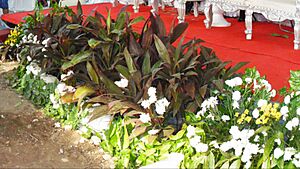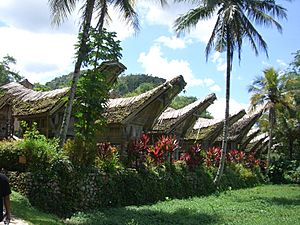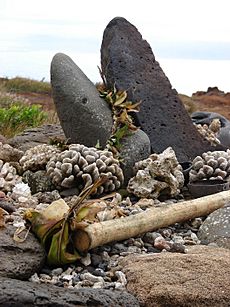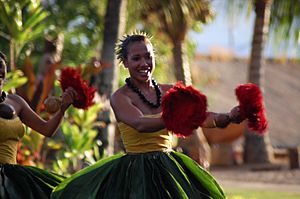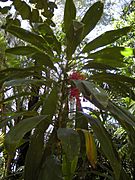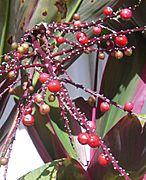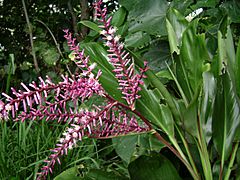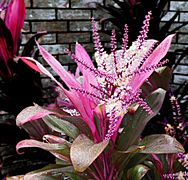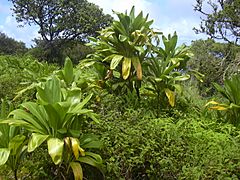Cordyline fruticosa facts for kids
Quick facts for kids Cordyline fruticosa |
|
|---|---|
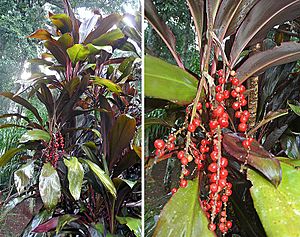 |
|
| Foliage and fruit | |
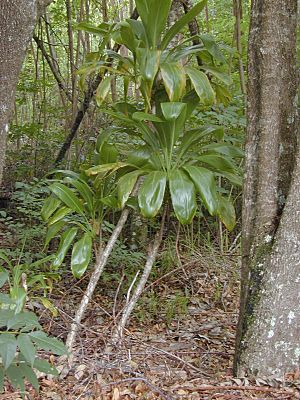 |
|
| Green C. fruticosa in Makawao Forest Reserve, Maui | |
| Scientific classification | |
| Synonyms | |
|
Convallaria fruticosa L. |
The Cordyline fruticosa is a beautiful evergreen plant. It has bright flowers and belongs to the Asparagaceae family. This plant is very important to many cultures in the Pacific Islands, New Zealand, and Southeast Asia. People use it for food, traditional medicine, and as a pretty plant in gardens. It's known by many names like ti plant, palm lily, and cabbage palm.
Contents
Plant Names and Meanings
The ti plant has many different names. These names often come from old languages spoken in the Pacific. For example, in Hawaiian, it's called kī. In Māori, it's called tī. Sometimes, these names are also used for other plants with colorful leaves.
In the Philippines, some names for the ti plant mean "to know". This is because people used it in special ceremonies to find out things about the future. In New Zealand, the name tī was also given to a similar native plant called the cabbage tree.
What the Ti Plant Looks Like
The ti plant looks a bit like a small palm tree. It can grow up to 3 to 4 meters (about 10 to 13 feet) tall. It has long, broad leaves that grow in a spiral pattern at the top of its stem. The leaves can be many different colors, from bright red to green or even mixed colors.
Its leaves are usually 30 to 60 centimeters (12 to 24 inches) long. They are about 5 to 10 centimeters (2 to 4 inches) wide. The plant also grows small, sweet-smelling flowers. These flowers can be yellowish or red. After flowering, they turn into small red berries.
Where Ti Plants Come From
Nobody knows exactly where the ti plant first grew. But it's thought to be from places like Bangladesh, Mainland Southeast Asia, South China, Taiwan, Island Southeast Asia, New Guinea, and Northern Australia. Many different types of ti plants are found in New Guinea. People believe it was grown there a lot in the past.
Ancient travelers called Austronesians carried the ti plant across the Pacific Ocean. They took it as far as Hawaii, New Zealand, and Easter Island. In some parts of eastern Polynesia, a special type of ti plant was grown. This type had large, edible roots. It was hard to grow from seeds, so people grew it from cuttings. This was probably done on purpose to get bigger, tastier roots for food.
How People Use Ti Plants
Cultural Importance
The ti plant is very important in the cultures of Austronesian and Papuan people. Many believe it has special powers. People often think it can bring good luck or protect against bad spirits. It is used in traditional clothes and decorations. It also helps mark land boundaries.
Different colored ti plants can have different meanings. Red ti plants often represent strength and connections to ancestors. Green ti plants usually stand for peace and healing. People also use them for traditional medicine and dyes. Even with new religions, the ti plant is still used in many cultural practices.
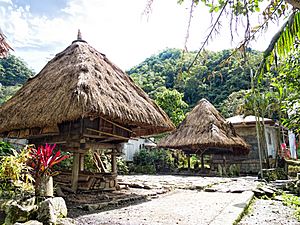
In the Philippines, the ti plant was often used by spiritual leaders. They believed the plant could host spirits. The Ifugao people plant it around their homes and fields. They think it keeps away bad spirits and marks their land. Red leaves were thought to attract spirits. People wore them during important ceremonies.
In Indonesia, red ti plants are used like in the Philippines. Many groups use them to protect against evil spirits and mark boundaries. They are also part of healing and funeral ceremonies. People often plant them near sacred places. Some groups even use ti plants to make green dye.
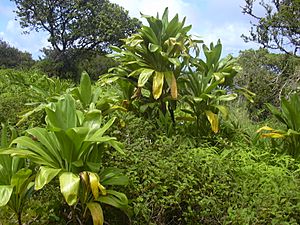
In New Guinea, ti plants show who owns land for farming. They are also planted around special men's houses. People use them in many rituals. Some groups believe they house spirits of warriors. After conflicts, they replant ti to mark new land borders. Some people believe ti plants have their own spirits and are very powerful. Red plants are used for good magic, and green plants for other types of magic.
In Island Melanesia, ti plants are considered sacred. They are used for protection, telling the future, and for good harvests. The Kwaio people use red ti for certain rituals and green ti for ancestor spirits. Women in New Britain wear ti leaves as everyday skirts. In Vanuatu, ti leaves are worn in traditional dances. In Fiji, red ti leaves are used for dancers' skirts and in ceremonies for the dead.
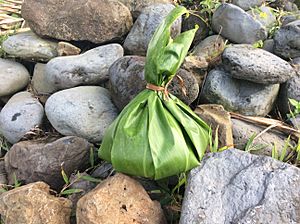
In Micronesia, ti leaves are buried under new houses. This is to protect against bad magic. Shamans in Micronesia use ti plants to talk to spirits of the dead. There is also proof that people ate the roots in Guam long ago.
In Polynesia, green ti plants were grown widely for food and religious reasons. They are often planted around homes, sacred places, and grave sites. People carry the leaves as a charm when they travel. They also use them in rituals to talk with spirits. Like in Southeast Asia, people believe they protect against bad luck. They also think spirits of people and nature can live in the plants.
In ancient Hawaiʻi, the ti plant was thought to have great spiritual power. Only special priests and chiefs could wear the leaves around their necks during rituals. Ti was sacred to the gods of farming and dance. Ti leaves were also used to make lei (flower necklaces). They helped mark property lines and were planted to keep evil spirits away. Even today, some Hawaiians plant tī near their homes for good luck. The leaves were also used for lava sledding. People would tie leaves together and slide down hills on them. The leaves were also used to make skirts for dancing.
In Aotearoa (New Zealand), some place names come from the ti plant. For example, Puketī Forest. There's a legend about ti plants in Kaingaroa. It says two women were turned into ti plants and seem to follow travelers.
Other Uses for Ti Plants
Ti plants are also used for traditional medicine, dyes, and as pretty decorations.
The flowers of Cordyline terminalis were traditionally used to treat asthma. Scientists have studied them to see if they could be a natural medicine.
In the Philippines, the roots were used to flavor traditional sugarcane wines.
In Polynesia, the green leaves are used to wrap food. They also line earth ovens and pits where breadfruit is fermented. The roots are harvested and made into a sweet, molasses-like paste. This paste is eaten like candy or used to make a honey-like liquid for sweet treats. In Hawaii, the roots are mixed with water and fermented into an alcoholic drink called okolehao. Fibers from the leaves are used to make ropes and bird traps. Eating ti as food was once forbidden because it was a sacred plant. But people started eating it during times of hunger.
Ti is a very popular ornamental plant. Many types are grown, chosen for their green, reddish, or purple leaves.
Gallery
See also
 In Spanish: Cordyline fruticosa para niños
In Spanish: Cordyline fruticosa para niños


